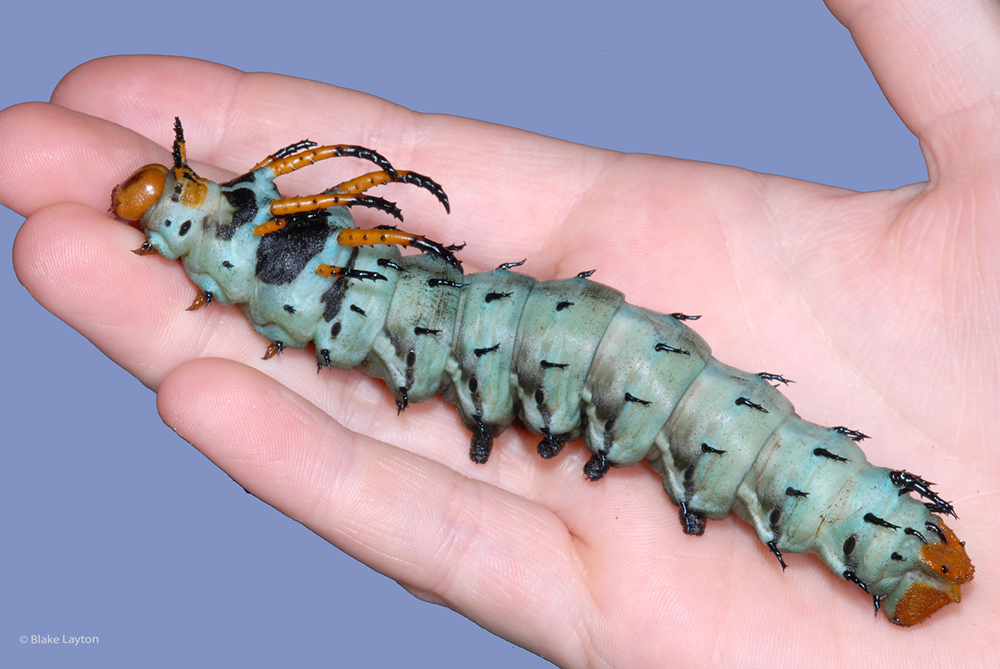Hickory Horned Devil Vol. 9, No. 25
Citheronia regalis
Order: Saturniidae
Family: Lepidoptera

“This caterpillar we just found is as big as a hotdog and has big orange horns on its back! The thing looks dangerous. Can it sting?”
Hickory horned devil caterpillars are the largest caterpillars in the country, with fully developed specimens reaching over five inches long. Despite their ominous name and those colorful, spiny horns, these caterpillars are harmless. Most sightings occur when fully mature caterpillars have left their host tree and are crawling around on the ground in search of a safe place to pupate. This “prepupal wandering phase” is a phenomenon that occurs with many caterpillar species.
As their name indicates, hickory horned devil caterpillars feed on the leaves of hickory and pecan, but they will also feed on other non-oak hardwoods, such as sweet gum, persimmon, ash, and sumac. Through much of the country there is only one generation per year, but we seem to have two, or at least a partial second generation in the deep South. These caterpillars are never numerous, but late summer and fall is when many sightings are reported. Younger/earlier instar caterpillars vary in color and are rarely seen because they stay up in the trees eating leaves.
If you encounter a wandering horn devil caterpillar this fall and want to try to rear it to adulthood, place it in a 1 gallon-plus-sized container with five to six inches of moist, but not wet, soil in the bottom, and maybe a thin layer of the kind of leaf litter that existed where it was found. If it is crawling on the ground, it should be finished feeding, so it should not need any leaves to eat, but add a few pencil-sized twigs to provide a perch for the emerging moth to use as it expands its wings.
Horn devil caterpillars pupate by digging into the soil to form a large, naked pupae, so there will not be a cocoon. Check the container periodically to be sure the soil does not get too dry (keep it moist, but not wet), and to check for an emerging moth. Avoid the temptation to dig around in the media to try to find the pupa—you might injure it.) If you keep it inside, don’t be surprised if the moth emerges well before spring, because the warmer indoor temperatures will hasten development. Of course, this will doom the moth to being unable to reproduce, because it is out of synch with the natural population. Also be aware that some caterpillars will harbor parasitic insects, such as the larvae of tachinid and sarchophagid flies, that live as pupal parasitoids. Sometimes you may get hairy medium-sized flies instead of a moth.
Spectacular caterpillars often become spectacular moths, and the name of these moths reflects their splendor. Adult hickory horned devils are called Regal Moths, or Royal Walnut Moths. These big, heavy-bodied moths have a wingspan of four to six inches and are tan and orange with yellow markings. This is the rare “Regalis Moth” that was so eagerly sought by Elnora in the 1909 novel, and subsequent movies, A Girl of the Limberlost.
Blake Layton, Extension Entomology Specialist, Mississippi State University Extension Service.
The information given here is for educational purposes only. Always read and follow current label directions. Specific commercial products are mentioned as examples only and reference to specific products or trade names is made with the understanding that no discrimination is intended to other products that may also be suitable and appropriately labeled.
Bug’s Eye View is now on Facebook. Join the Bug's Eye View Facebook group here.
